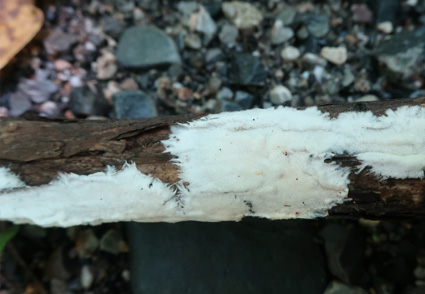Abstract
Perenniporia subrhizomorpha is introduced as a new species from North China on the basis of morphological and molecular evidence. Phylogenetically, based on ITS and nLSU regions, P. subrhizomorpha nested with two species belong to Perenniporia s.s. as a distinct lineage. Perenniporia subrhizomorpha is characterized by having an annual habit, resupinate and papery basidiomes, a dimitic hyphal system with crystal-covered generative hyphae in context, ellipsoid, truncated, dextrinoid basidiospores (5.7–6.5 × 4.3–5.5 μm), and absence of cystidia and cystidioles. Morphologically similar and phylogenetically related species to the new species are discussed.
References
Cui, B.K., Li, H.J., Ji, X., Zhou, J.L., Song, J., Si, J., Yang, Z.L. & Dai, Y.C. (2019) Species diversity, taxonomy and phylogeny of Polyporaceae (Basidiomycota) in China. Fungal Diversity 97: 137–302. https://doi.org/10.1007/s13225-019-00427-4
Cui, B.K. & Zhao, C.L. (2012) Morphological and molecular evidence for a new species of Perenniporia (Basidiomycota) from Tibet, southwestern China. Mycoscience 53: 365–372. https://doi.org/10.1007/s10267-011-0180-x
Dai, Y.C., Niemelä, T. & Kinnunen, J. (2002) The polypore genera Abundisporus and Perenniporia (Basidiomycota) in China, with notes on Haploporus. Annales Botanici Fennici 39: 169–182.
Decock, C. (2001a) Studies in Perenniporia. Some Southeast Asian taxa revisited. Mycologia 93: 774–795. https://doi.org/10.1080/00275514.2001.12063210
Decock, C. (2001b) Studies in Perenniporia: African taxa I. Perenniporia dendrohyphidia and Perenniporia subdendrohyphia. Systematics and Geography of Plants 71: 45–51. https://doi.org/10.2307/3668752
Decock, C. & Ryvarden, L. (2003) Perenniporiella gen. nov. segregated from Perenniporia, including a key to neotropical Perenniporia species with pileate basidiomes. Mycological Research 107 (1): 93–103.
Decock, C., Figueroa S.H. & Ryvarden, L. (2001) Studies in Perenniporia. Perenniporia contraria and its presumed taxonomic synonym Fomes subannosus. Mycologia 93: 196?204. https://doi.org/10.2307/3761616
Decock, C. & Stalpers, J.A. (2006) Studies in Perenniporia: Polyporus unitus, Boletus medulla-panis, the nomenclature of Perenniporia, Poria and Physisporus, and a note on European Perenniporia with a resupinate basidiome. Taxon 55 (3): 759–778.
Du, P., Wang, C.G. & Tian, X.M. (2020) Perenniporia eugeissonae sp. nov., a new species on palm discovered from Malaysia. Phytotaxa 449 (1): 75–82.
Guindon, S. & Gascuel, O. (2003) A simple, fast and accurate algorithm to estimate large phylogenies by maximum likelihood. Systematic Biology 52: 696–704. https://doi.org/10.5943/mycosphere/8/8/10
Katoh, K., Kuma, K., Toh, H. & Miyata, T. (2005) MAFFT version 5: improvement in accuracy of multiple sequence alignment. Nucleic Acids Research 33: 511–518.
Katoh, K. & Standley, D.M. (2013) MAFFT multiple sequence alignment software version 7: improvements in performance and usability. Molecular Biology and Evolution 30: 772–780.
Kotlába, F., & Pouzar, Z. (1964) Staining spores of Homobasidiomycetes in cotton blue and its importance for taxonomy. Feddes Repertorium Specierum Novarum Regni Vegetabilis 69: 131–142.
Kotlába, F., & Pouzar, Z. (1973) Donkioporia Kotl. & Pouz., a new genus for Poria megalopora (Pers.) Cooke. Persoonia - Molecular Phylogeny and Evolution of Fungi 7 (2): 213–216.
Murrill, W.A. (1905) The Polyporaceae of North America: XII. A synopsis of the white and bright-colored pileate species. Bulletin of the Torrey Botanical Club 32 (9): 469–493.
Murrill, W.A. (1942) Florida resupinate polypores. Mycologia 34 (5): 595–596.
Pattengale, N.D., Alipour, M., Bininda-Emonds, O.R.P., Moret, B.M.E. & Stamatakis, A. (2010) How many bootstrap replicates are necessary? Journal of Computational Biology 17: 337–354. http://dx.doi.org/10.1089/cmb.2009.0179
Petersen, J.H. (1996) Farvekort. The Danish Mycological Society’s colour-chart. Foreningen til Svampekundskabens Fremme, Greve.
Pilát, A. (1953) Hymenomycetes novi vel minus cogniti Cechoslovakiae. II. Acta Musei Nationalis Pragae 9B (2): 1–109.
Posada, D. (2008) jModelTest: phylogenetic model averaging. Molecular Biology and Evolution 25: 1253–1256.
Reid, D.A. (1973) A reappraisal of type and authentic specimens of Basidiomycetes in the van der Byl herbarium, Stellenbosch. South African Journal of Botany 39 (2): 141–178.
Robledo, G.L., Amalfi, M., Castillo, G., Rajchenberg, M. & Decock, C. (2009) Perenniporiella chaquenia sp. nov. and further notes on Perenniporiella and its relationships with Perenniporia (Poriales, Basidiomycota). Mycologia 101: 657–673. https://doi.org/10.5248/132.867
Ronquist, F., Teslenko, M., van der Mark, P., Ayres, D., Darling, A., Höhna, S., Larget, B., Liu, L., Suchard, M.A. & Huelsenbeck, J.P. (2012) MrBayes 3.2: efficient Bayesian phylogenetic inference and model choice across a large model space. Systematic Biology 61: 539–542.
Ryvarden, L. (1983) Two Perenniporia species from Pakistan. Mycotaxon 17: 517–520.
Ryvarden, L. (1998) African polypores: a review. Belgian Journal of Botany 131: 150–155.
Silvestro, D. & Michalak, I. (2012) raxmlGUI: a graphical front-end for RAxML. Organisms Diversity and Evolution 12: 335–337. http://dx.doi.org/10.1007/s13127-011-0056-0
Stamatakis, A. (2006) RAxML-VI-HPC: maximum likelihood-based phylogenetic analyses with thousands of taxa and mixed models. Bioinformatics 22: 2688–2690. http://dx.doi.org/10.1093/bioinformatics/btl446
Teixeira, A.R. (1993) Chave para identificação dos gêneros de Polyporaceae com base na morfologia dobasidiocarpo. Boletim do Instituto de Botânica 8: 1–55.
Vilgalys, R. & Hester, M. (1990) Rapid genetic identification and mapping of enzymatically amplified ribosomal DNA from several Cryptococcus species. Journal of Bacteriology 172: 4238–4246.
Wang, C.G., Liu, S.L. & Wu, F (2020) Two new species of Perenniporia (Polyporales, Basidiomycota). MycoKeys 69: 53–69. https://doi.org/10.3897/mycokeys.69.51652
White, T.J., Bruns, T.D., Lee, S.B & Taylor, J.W. (1990) Amplification and direct sequencing of fungal ribosomal RNA genes for phylogenetics. In: Innis, M.A., Gelfand, D.H., Sninsky, J.J. & White, T.J. (Eds.) PCR Protocols: A guide to methods and applications. Academic Press, New York, pp. 315–322.
Wu, Z.Q., Liu, W.L., Wang, Z.H. & Zhao, C.L. (2017) Perenniporiopsis, a New Polypore Genus Segregated from Perenniporia (Polyporales). Cryptogamie Mycologie 38: 285–299. https://doi.org/10.7872/crym/v38.iss3.2017.285
Zhao, C.L. & Cui, B.K. (2013a) Morphological and molecular identification of four new resupinate species of Perenniporia (Polyporales) from southern China. Mycologia 105: 945–958. https://doi.org/10.3852/12-201
Zhao, C.L. & Cui, B.K. (2013b) Three new Perenniporia (Polyporales, Basidiomycota) species from China based on morphological and molecular data. Mycoscience 54: 231–240. http://dx.doi.org/10.1016/j.myc.2012.09.013
Zhao, C.L., Cui, B.K. & Dai, Y.C. (2013) New species and phylogeny of Perenniporia based on morphological and molecular characters. Fungal Diversity 58: 47–60. http://dx.doi.org/10.1007/s13225-012-0177-6
Zhou, L.W. & Dai, Y.C. (2012) Wood-inhabiting fungi in southern China 5. New species of Theleporus and Grammothele (Polyporales, Basidiomycota). Mycologia 104: 915–924. https://doi.org/10.3852/11-302


